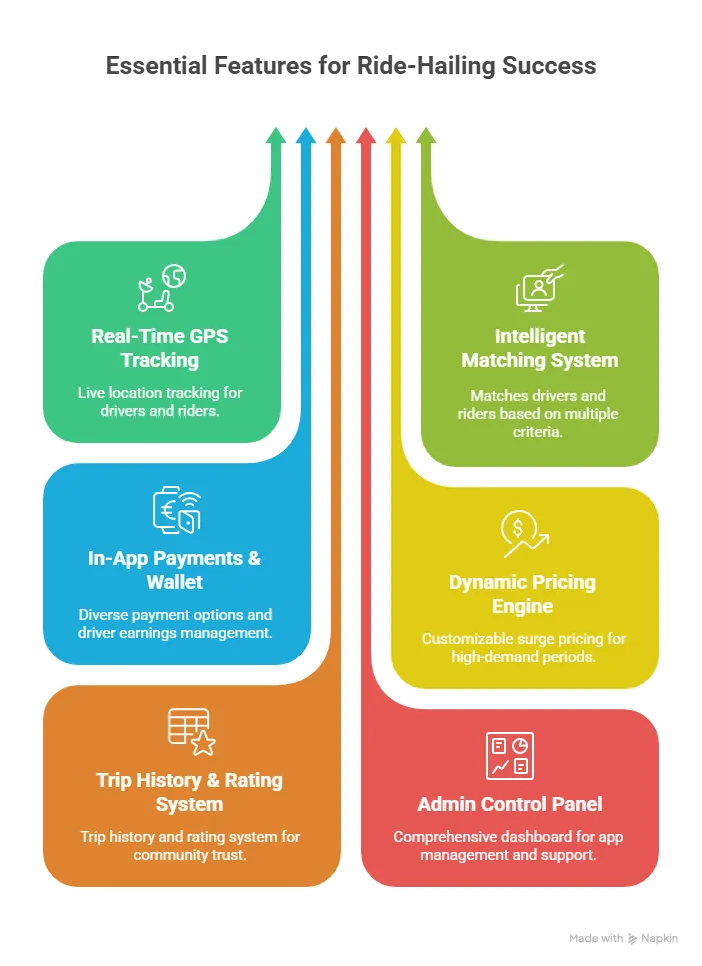The way we move has changed — forever. Remember flagging down a cab in the rain? Or waiting for a dispatch operator to finally send a driver your way? That system’s been left in the dust. Ride-hailing apps like Bolt, Uber, and Lyft didn’t just disrupt transportation — they redefined it. And even as the big players dominate headlines, there’s massive opportunity for regional and niche players.
In fact, with growing concerns over driver wages, commission cuts, and lack of localization in major apps, riders and drivers alike are looking for better alternatives. That’s where launching your own ride-hailing platform — powered by a Bolt clone script — becomes a very real and viable business opportunity.
In 2025, the market for ride-hailing is far from saturated. From rural connectivity to electric mobility, from women-only ride platforms to hyper-local logistics, there’s room for innovators with the right tech. If that’s you, here’s everything you need to know before launching your own Bolt-like app.
What Is a Bolt Clone?
A Bolt clone is a ready-made app script that mimics the features and flow of the Bolt ride-hailing platform. It includes all the core components: a rider app, a driver app, and a robust admin panel — built to help you launch a transportation business without reinventing the wheel.
Unlike generic taxi software, a Bolt clone is designed for scalability, multi-city expansion, and real-time matching between supply (drivers) and demand (riders). Most scripts include essential integrations such as maps, wallets, surge pricing, and ride-tracking.
Whether you’re building for a single city, a college campus, or a national rollout, a clone script gives you the foundation you need — faster and at a lower cost than custom development.
Read More : Reasons startup choose our bolt clone over custom development
Must-Have Features in a Bolt Clone Script

You can’t launch a modern ride-hailing app with outdated features. In 2025, users expect seamless experiences and robust safety protocols. The must-haves include:
1. Real-Time GPS Tracking
Both drivers and riders should be able to track locations live — from pickup to drop-off. Map accuracy and performance are critical.
2. Intelligent Matching System
Your app should match drivers and riders based on proximity, rating, vehicle type, and traffic conditions — not just blindly assign whoever is closest.
3. In-App Payments & Wallet
Allow riders to pay through cards, wallets, UPI, or other local methods. Enable drivers to withdraw their earnings or use them for fuel credits.
4. Dynamic Pricing Engine
Surge pricing during high-demand hours, weather events, or regional events should be customizable in your backend.
5. Trip History & Rating System
Both drivers and riders should be able to view past trips, report issues, and rate each other to build community trust.
6. Admin Control Panel
You’ll need a dashboard to manage users, vehicles, payments, commissions, support tickets, and city-specific settings.
7. Driver Onboarding & Verification
Make it easy (but secure) for drivers to sign up, upload documents, and start earning. Automated approvals or manual screening options are key.
Read More : Build a Ride Hailing Platform: Your Complete Bolt Clone Guide
Cost Factors & Pricing Breakdown
Bolt-Like Ride-Hailing App Development — Market Price
| Development Level | Inclusions | Estimated Market Price (USD) |
|---|---|---|
| 1. Basic Ride-Hailing MVP | Rider login, driver signup, ride requests, fare estimates, trip tracking, basic wallet, simple driver & rider panels, and a basic admin dashboard. | $50,000 |
| 2. Mid-Level Ride-Hailing Platform | Web + mobile interfaces, real-time tracking, route optimization, surge pricing, driver payouts, ratings & reviews, notifications, multiple payment methods, and analytics. | $120,000 |
| 3. Advanced Bolt-Level Platform | Multi-city control panel, fleet management, subscriptions, incentive programs, corporate ride modules, advanced mapping, automated payouts, and enterprise-grade scalability. | $240,000+ |
These market rates reflect the global development cost for building a Bolt-style ride-hailing ecosystem — including real-time navigation, fleet workflows, payments, and rider-driver interactions.
Miracuves Pricing for a Bolt-Like Platform
Miracuves Price: $2,899
This includes a fully functional ride-hailing solution with rider app, driver module, fare engine, live tracking, wallet integration, promotions, trip history, and a comprehensive admin backend — ready for branding and deployment.
Note:
Includes full non-encrypted source code, backend setup, deployment support, API integrations, and admin configuration — ensuring your Bolt-style ride-hailing platform is launch-ready in minimal time.
Start Your Bolt-Style Ride-Hailing Business — Contact Us Today
Delivery Timeline for a Bolt-Like Platform with Miracuves
A typical delivery timeline is 3–9 days, depending on:
- Required geographic coverage
- Fare logic & surge configuration
- Driver onboarding & verification settings
- Branding and UI customization
- Payment gateway and notification integrations
- Additional fleet or corporate modules
Tech Stack
Built using PHP, delivering reliable performance, strong scalability, secure API operations, and efficient real-time interactions essential for ride-hailing and fleet-based applications.
Read More : How to Build a Ride App That Lets Users Negotiate Fares in 30 Days
How Bolt Clone Owners Make Money
Your ride-hailing platform doesn’t just serve a transportation need — it builds a consistent revenue stream. Here are common monetization models:
- Commission per Ride: Take a fixed or percentage cut from every completed ride.
- Surge Pricing Profits: Retain part or all of the extra fees during high-demand periods.
- Driver Subscription Plans: Offer monthly plans for unlimited ride acceptance or higher visibility.
- Promotional Ad Slots: Sell ad space to local businesses, fuel stations, or insurance providers.
- Corporate Tie-ups: Provide transport services to companies with bulk ride needs and contracts.
You can layer these models depending on your region’s economics and rider behavior.
Why Ride-Hailing Is Still a Smart Business in 2025
With global traffic, urban expansion, and environmental concerns, smart mobility is more critical than ever. Here’s why launching your Bolt clone now makes sense:
1. Localized Services Matter
Riders want familiar, responsive services that reflect their city’s culture, language, and fare structure. A local platform can beat global apps on relevance.
2. Electric Vehicles & Green Transport
As electric scooters, bikes, and EV cabs go mainstream, your platform can focus on sustainable transport — and access green subsidies.
3. Driver-Centric Models Are Rising
Drivers are tired of high commissions and slow payouts from big apps. Your platform can offer fairer terms and attract loyal supply.
4. Tier-2 & Tier-3 Cities Are Underserved
Major cities are saturated. But smaller towns are catching up and need smart transport solutions that the big players overlook.
5. Integration with Other Services
Your ride app can expand to include deliveries, carpools, rentals, or even public transport ticketing — creating a mobility ecosystem.
What to Look for in a Bolt Clone Script Provider
Before purchasing any script, ask yourself (and your provider):
- Can the platform handle 1,000+ concurrent users?
- Is it customizable for multi-language, multi-currency, and local payment gateways?
- Does it include driver background verification tools?
- Is there post-launch support or training?
- Can you launch Android and iOS apps easily?
- Are maps and routing optimized for your region?
Launching is just step one — sustaining and scaling the platform require reliable tech infrastructure and a clear roadmap.
Read More : Revenue Model of Bolt: How the Super App of Mobility Makes Money
Final Thoughts
People may not talk about ride-hailing apps the way they did a few years ago, but that’s only because they’ve become a part of daily life. Seamless, safe, and on-demand transport is no longer a luxury — it’s an expectation. And that means opportunity for builders with vision.
At Miracuves, we help innovators launch high-performance app clones that are fast, scalable, and monetization-ready. Ready to turn your idea into reality? Let’s build together.
Still have questions about Bolt clone scripts? Let’s clear them up.
Can I launch a Bolt clone in a single city?
Yes, and it’s often a smart strategy. Start with one region, build traction, then expand based on demand and resources.
Do I need a large team to manage it?
Not initially. With an efficient admin panel, you can manage daily operations with a small support and tech team.
How do I onboard drivers quickly?
Offer easy app sign-up, automated ID checks, and incentive bonuses for early adopters. Partner with local driver groups if possible.
Is ride-hailing still profitable?
Yes. Especially when focused on underserved regions or offering better terms for drivers. Operational efficiency is key.
Can I include bike and scooter rides?
Yes. Most clone scripts allow vehicle-type configuration. You can launch with cabs, then add scooters or e-bikes over time.
What’s the biggest technical challenge?
Handling real-time GPS tracking and routing efficiently is the toughest. Choose a script built on modern mapping APIs and infrastructure.
Related Articles








